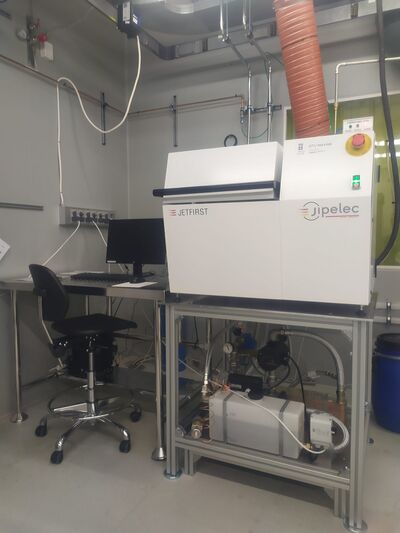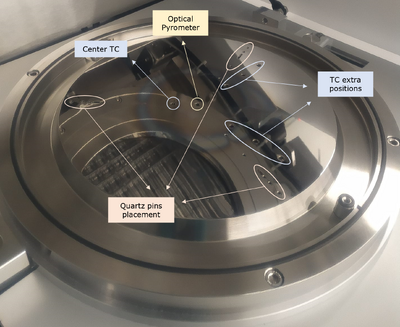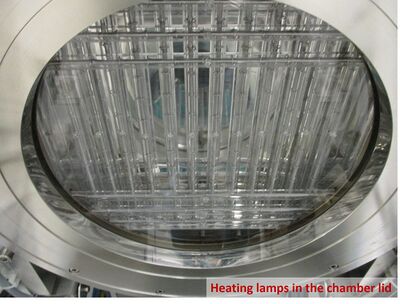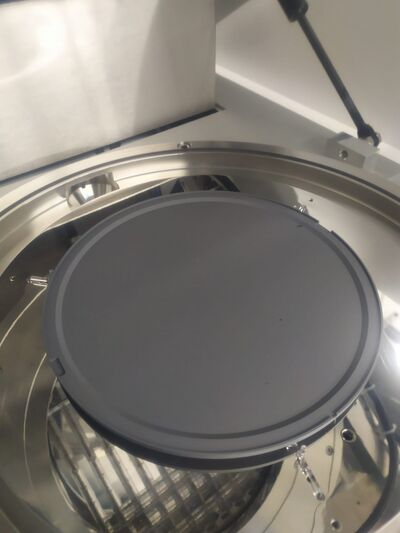Specific Process Knowledge/Thermal Process/RTP Jipelec 2
Feedback to this page: click here
This page is written by DTU Nanolab internal
THIS PAGE IS UNDER CONSTRUCTION
RTP2 Jipelec - Rapid Thermal Processor
This page is written by Inês Diogo@DTU Nanolab if nothing else is stated.

The main purpose of the RTP2 Jipelec (Jipelec JetFirst 200 RTP) is to perform thermal processes, using faster heating rates and shorter process durations when compared to conventional methods. This is called rapid thermal processing (RTP) and can be used to treat different types of samples.
Rapid thermal processing typically includes RTA, i.e. Rapid Thermal Annealing, where samples are heated up very rapidly in a nitrogen or argon atmosphere. Contact alloying and RTN, i.e. Rapid Thermal Nitridation, might also be possible for some samples.
The Set-Up
The machine consists of a reactor chamber, in which different samples can be processed/annealed at temperatures up to 1200 °C.
The chamber can be heated up very rapidly by the use of 18 infrared halogen lamps that are situated in the chamber lid. A quartz plate is placed below the lamps, i.e. between the lamps and the sample(s). Below the platen, there is an optical pyrometer aligned with the center of the substrate, that is placed on the bottom part of the chamber. The platen presents additional inlets where multiple thermocouples can be mounted (image on the right).

The lamps are divided in three zones so that a uniform temperature can be obtained over the substrate. During the heating, the quartz window below the lamps will get warm. However, the chamber walls are cooled by a cooling water flow and thus remain cold to prevent sample contamination. As already mentioned, the cooling unit is located under the machine. The lamps are cooled by cooling fans (no noisy compressed air cooling like in the old Jipelec RTP). The halogen lamps and the quartz plate are visible in the image below.

The samples are placed above the round metal plate in the bottom of the chamber, i.e. below the halogen lamps. The substrates are meant to be placed on top of three quartz pins. Depending on the type and size of the substrate, there are three types of quartz pins available (for the SiC-coated graphite susceptor, a 100 mm wafer and for a 150 mm wafer). Nonetheless, the susceptor should always be used, when possible (except for 8" wafers).

Temperature Measurement and Control
The temperature of the substrate can be controlled by use of either a thermocouple (TC) or an optical pyrometer (Pyro). This control system is called the closed loop mode, i.e. the temperature control mode. An open loop mode (power control mode), on the other hand, is not recommended. In this case, the temperature of the substrate would vary according to the power emitted by the lamps established as setpoint, without any limiting check from the pyrometer or thermocouple. Thus, it can happen that the chamber is heated up very fast with no actual temperature control, which can induce serious damages to the tool.
When using the temperature control mode, the thermocouple is usually the recommended sensor. However, this recommendation varies a lot depending on the desired conditions for the process. See the table below.
| Room temperature to 400 °C | 400 °C to 850 °C | 850 °C to 1000 °C | 1000 °C to 1200 °C | ||
| Pressure conditions | Vacuum | TC control | Pyro Control | Pyro Control | Pyro Control* |
| No Vacuum | TC control | TC control | TC Control | Pyro Control* | |
*Important! The thermocouples are not intended to be used for high-temperature processes - a lifetime reduction can be expected if they are used in such conditions. Therefore, when processing at 1000 °C or above, the thermocouples must be pulled down. Consequently, the pyrometer should be chosen as the temperature control method in the recipe. These changes to the thermocouples should only be carried out by the responsible persons.
While processing, it is possible to have three thermocouples measuring the temperature - TC1, TC2 and TC3 - in conjugation with the optical pyrometer.
- TC1 - This is called the control thermocouple, and when possible, it should always be connected. When using a susceptor, it corresponds to a long, thin TC that is placed in a hole at the edge of the susceptor. On the other hand, if a wafer is directly placed on top of the quartz pins or a carrier wafer is being used, it is not possible to use this long TC. Thus, TC1 corresponds to a thick TC positioned in contact with the back of the wafer/carrier, approximately in the center. Regardless its type, it is very important that the TC is placed correctly and that contact with the substrate is ensured, otherwise the temperature measurement will not be correct.
- TC2 and TC3 - These are reference TCs and can be placed in other six positions in the platen (see image in section 6.2). They are not controlling the temperature, and they do not need to be present. The TCs can for instance be used to measure the temperature uniformity over a wafer or susceptor. However, the temperature measurement, and ultimately the uniformity interpretation, will always be very dependent on the quality of the contact between each TC and the wafer or susceptor.
- Optical Pyrometer - The pyrometer is making an non-contact optical temperature measurement in the center of the susceptor or wafer. To ensure that the temperature measured by the pyrometer is correct, a temperature calibration must be done, for which the TC1 is used as a reference. To get the most correct temperature measurement, a pyrometer calibration should be done for each substrate type, thickness, size, material and each desired process.
The machine has a PID regulator for the temperature control. For each substrate type, thickness, size, material and desired process these PID settings have to be optimized in order to ensure that the actual temperature matches the settings as good as possible and no damage is induced to the tool while processing.
Samples and Process Specifications
| Specifics | Range | Comments | |
|---|---|---|---|
| Temperature | Pyro Control |
|
|
| Thermocouple Control |
|
||
| Process gas | Argon (Ar) |
|
|
| Nitrogen (N2) |
|
||
| Forming gas (4% H2/ 96% N2) |
|
Gas line not connected yet. | |
| Nitrogen purge (N2) |
|
Do not use for processing. | |
| Pressure | No vacuum |
|
|
| Vacuum |
|
5/6 mbar, if minimum gas flow is used during process. | |
| Process time*
(Check image below) |
At 1200 oC |
|
|
| At 1100 oC |
|
||
| At 1000 oC |
|
||
| At 900 oC |
|
||
| At 800 oC |
|
||
| At 700 oC |
|
||
| < 700 oC |
|
||
| < 500 oC |
|
||
| Heating rate |
|
At faster heating rates, the actual temperature might overshoot from the temperature setpoint in the recipe, and the susceptors/carriers might break. | |
| Substrates | Batch size |
|
|
| Substrate size |
|
Small samples must be placed on dedicated carrier wafers/susceptors. These do not need to and should not be bonded to the carriers. | |
| Allowed materials |
|
Always check the cross contamination information in LabManager to see whether your samples are allowed in the RTP2 Jipelec before using it. If you want to anneal sample materials that are not on the list or not approved, please contact the Thin Film group | |
*Remark! The time limits are not implemented in the software, but it is very important to obey these. If processing is done for longer times than those defined in the table, there is a certain risk that the chamber gets overheated, which can lead to damage of the equipment.
Additional information
The user manual, user APV, technical and contact information can be found in LabManager: RTP2 Jipelec
